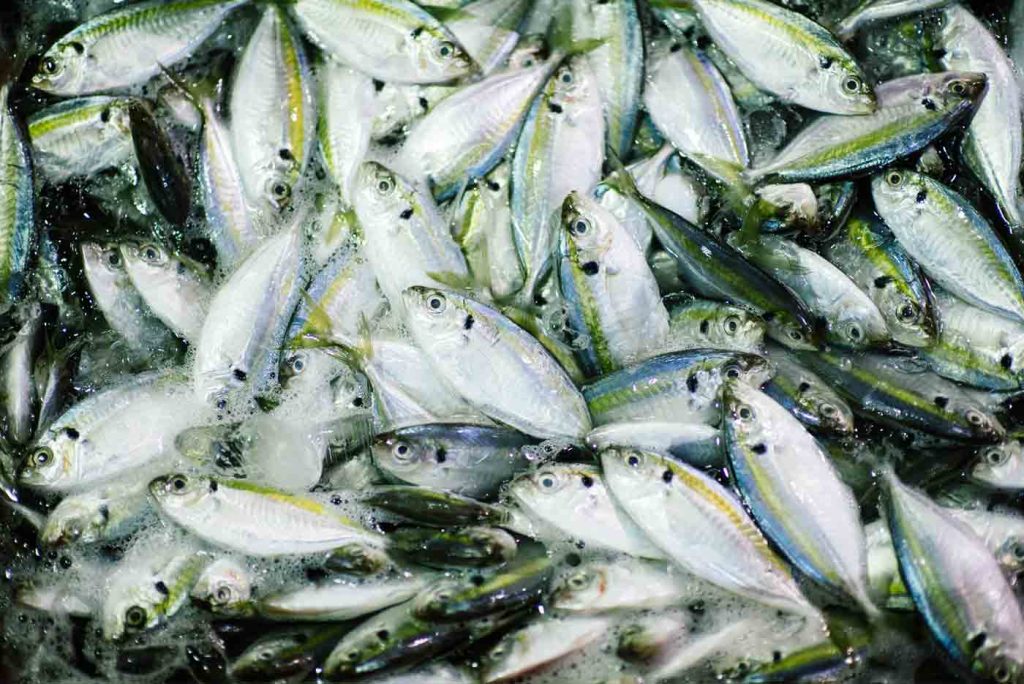The morning of the life release, I met Semo Saraswati at the Kalimati market in Kathmandu. I followed my nose through a labyrinth of vegetable vendors to the fish section to find the elusive lama.
After turning a particularly stinky corner, I walked into a cramped alley. One side was lined with rickety trucks, the other with vendor stands. Dead silver and white fish stared blankly from pyres of ice, flanked by plastic bins brimming with lifeless shellfish. Behind the displays, vendors sloshed around in two feet of grimy water, where fish swam skittishly around their ankles in sunken concrete tanks.
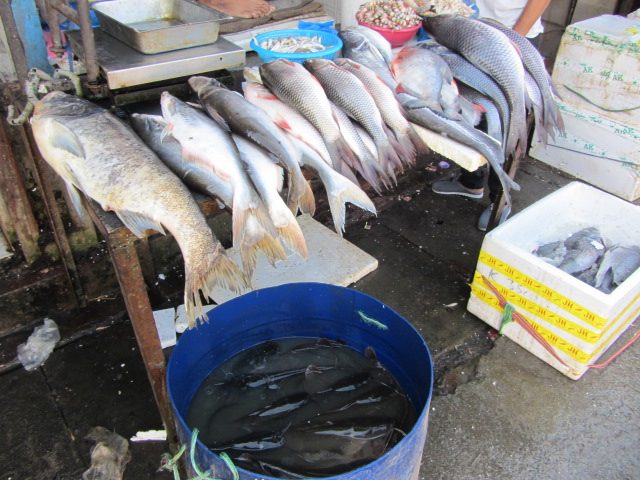
Away from the crowd, Semo Saraswati sat on a wicker stool, wearing a pink polo and flowered skirt. Her face was disguised by pale blue surgical mask—a common accessory given Kathmandu’s poor air quality—and simple black sunglasses. A trio of young boys next to her weighed a styrofoam box. Inside, dark catfish, each about a foot long, were piled four deep and squirming. Once weighed, the fish were dumped into a truck bed, where a makeshift tank had been erected using a tarp and bungee cords. Box after box of fish was weighed and the loaded into the truck.
Semo Saraswati is a Tibetan lama who lives on the outskirts of Kathmandu. That weekend, she was buying hundreds of fish to release into the Trishuli River, a major waterway just outside the Kathmandu Valley.
Like her late father, the famed Dzogchen master Chatral Rinpoche, Semo Saraswati practices tshethar, or life release. As with other Buddhist traditions, life release is the practice of buying an animal destined for slaughter or a life of captivity and releasing it.
Despite the best intentions of practitioners, life release often causes more problems than it solves—especially when nonnative species are released into foreign environments, harming native wildlife and the released animals themselves.
The practice has become controversial over the past few decades. Among the most infamous instances was the ecologically catastrophic release of nonnative crustaceans into the English Channel in 2015, when two Buddhist students of the Taiwanese master Hai Tao released hundreds of lobsters and crabs off the coast of Brighton, damaging local marine life.
Another point of criticism is that life release has fallen away from its original intention—saving animals destined for a life of captivity or death—and become a self-serving ritual wherein animals and environments suffer for the sake of merit-making and promoting longevity.
Semo Saraswati’s intentions were clear that day. She wasn’t releasing these fish as a magical rite to lengthen her own life or get a pay raise, but to honor tens of thousands of animals that would be sacrificed the following week for Dasain, the most important Hindu festival in Nepal.
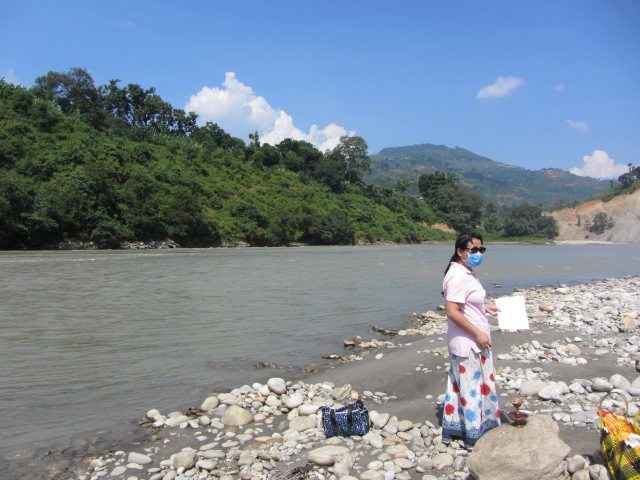
This 11-day festival commemorates the victory of the Hindu goddess Durga over a savage water buffalo demon. Goats, pigs, water buffalo, and other hoofed creatures are sacrificed to celebrate the triumph of good over evil. The Himalayan Times estimated that 50,000 goats were sold and sacrificed in the Kathmandu Valley over the course of the festival, which took place from September 21 to October 2, 2017.
Last year, Semo Saraswati released hundreds of goats destined for sacrifice in a predominantly Buddhist area, the Yolmo Valley north of Kathmandu, before Daisan.
“When they got to the mountains they got sick and died,” she said. “Very smelly. They ate so much grass; 700 goats eating grass. Winter is coming soon, there is not enough food [for the goats]. This year, there is a grass shortage.”
Kelsang Lama, who lives in the nearby village of Melamchi Gaon, said the goats couldn’t adapt to the forested cliffs and cold, high altitude climate. Nearby villagers collected many of the goats’ corpses and salvaged the meat, he said. Though he knows of one goat that did survive. It currently lives in his neighbor’s garden.
This year, because releasing more goats would have meant sending them to their death, Semo Saraswati decided to release fish instead. But the intended benefits extended far beyond the fish that were released. The concluding prayers and aspirations included all sentient beings, especially the animals sacrificed for Dasain.
The benefit of aspirations prayers is subtle—they didn’t save any animals from being slaughtered the following week, during the last days of September. Khenpo Gyaltsen, the head scholar at Ka-Nying Shedrub Ling monastery in Boudhanath, likened these prayers to good vibrations.
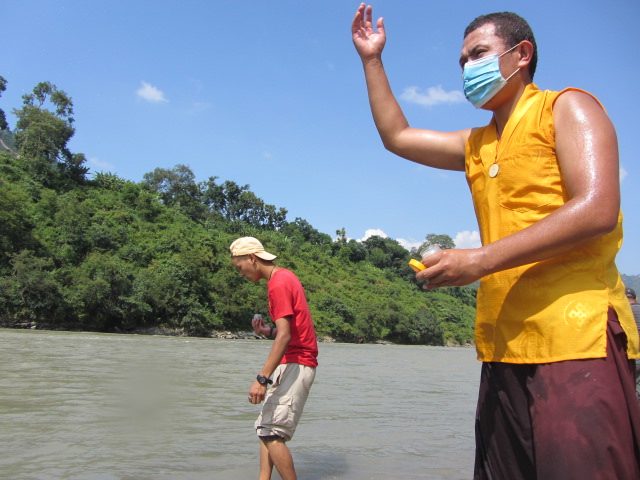
“That good-heartedness, that vibration you can say, influences, touches other people, 100 percent,” he said.
He gave the example of one person’s happiness influencing someone else’s state of mind. When one person smiles at someone else, for instance, usually that person will smile back. In the bardo—the intermediate state between death and rebirth—aspiration prayers are like a smile. They are a source of positive energy. At Ka-Nying Shedrub Ling, the monks spent three days reciting the Shitro Narak Dongtruk puja [ceremony] during days when the sacrifices were made. The puja was focused on Avalokitesvara, the bodhisattva of compassion.
Khenpo Gyaltsen said that aspiration prayers can’t be the cause of someone else’s spiritual liberation—that is up to each individual sentient being’s unique karma—but it can be a conducive condition.
“The cause, you must do yourself,” he said. “It’s your karma. If you accumulate some good karma, that can become a cause. So, through that, my good actions and my dedications can become conditions.”
Despite the power of aspiration prayers and blessings, the problematic consequences of life release practices still stand. According to Humane Society International, mercy release is a multimillion dollar industry.
A 2012 study published in Biological Conservation found that nearly 700,000 birds are captured in Cambodia each year and sold into the life release trade. Native populations of the red avadavat and the yellow-breasted bunting are declining at dangerous rates. These birds also carry pathogens that pose public health hazards. These birds are released into foreign cities by the thousands—Buddhist temples in Hong Kong release an estimated 580,000 birds a year.
Semo Saraswati didn’t buy the fish she released into the Trishuli River or the goats she released last year from mercy release retailers. She purchased the fish from a market, where they were waiting to be sold to hungry customers, and the goats from a market that sells animals to be sacrificed for Dasain. But, like the freezing goats, the fish were not native to Nepal.
University of Carolina Asheville fisheries expert David Gillette, who completed a Fulbright research study on fisheries in Nepal last year, identified the fish as Clarius gariepinus, a catfish that originated in North Africa and introduced to Nepal for aquaculture in the late 1990s.
“The Trishuli is much colder than their native waters, so I think it is unlikely that the fish survive for very long, especially with winter coming on,” Gillette wrote in an email. “That said, nature often ‘finds a way,’ and it is certainly possible that they could become a viable population.”
Gillette said that if the fish survive, they are “likely to negatively impact small native fishes, as they are naturally predators.”
Concepts of “native” and “nonnative” are fairly recent compared to many Tibetan Buddhist traditions. Like the older generations of practitioners who performed life releases in Tibet, Nepal, and India, lamas like Semo Saraswati are focused on directly improving the conditions for individual animals they release and dedicating the merit gained from that generosity for the benefit of other suffering beings.
“An animal cannot shout, cannot talk, cannot escape. No choice,” Semo Saraswati said.
In response to the question of releasing nonnative species, Khenpo Gyaltsen said that if a practitioner knows an animal won’t live long or will cause harm in a certain place, it is not beneficial to release it there.
“If you do there, maybe a big fish is going to eat the small one, and you already know that but again put a small fish there, then that is not life release,” he said.
He said if someone doesn’t know that an animal will not live long in a certain place but has a good heart, then, even if the animal dies soon thereafter or causes problems, the life release is still beneficial. For the modern practitioner, perhaps the responsibility of learning the environmental logistics of a particular release beforehand will have to become part of the practice.
Khenpo Gyaltsen said there are other ways to practice life release, such as vegetarianism, especially on auspicious days. In some Buddhist areas of Nepal and Tibet, hunting and cutting down trees is prohibited, and these measures can protect the lives of animals as well.
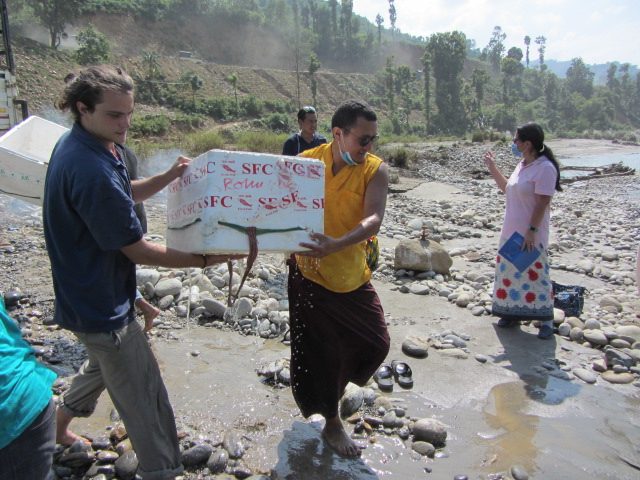
On the day of the life release ceremony, we drove for three hours through bumpy, winding Himalayan foothills to the Trishuli River. It was a motley caravan: two taxis followed by a rusty truck filled with catfish. We passed through roadside towns and villages, where goats stood tied outside family homes in anticipation of upcoming festival. They munched on hay or enjoyed the sunshine, unperturbed by the dust and traffic.
When our cab finally made it to the Trishuli, Semo Saraswati was already there. A few helpers were taking styrofoam boxes filled with fish and dumping them into the river’s pale brown water. She looked on and read prayers. After about an hour, the truck was empty.
All the fish survived the journey except one. Its body lay in the sand on the riverbank. The hundreds of survivors lingered in a dark school around the shallows for a few minutes before swimming away. An attendant tossed bits of blessed salt over them, and we turned around and went home.
Thank you for subscribing to Tricycle! As a nonprofit, we depend on readers like you to keep Buddhist teachings and practices widely available.
